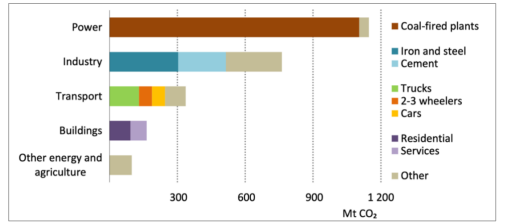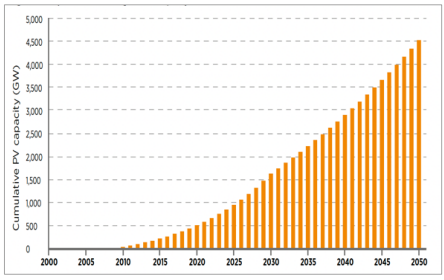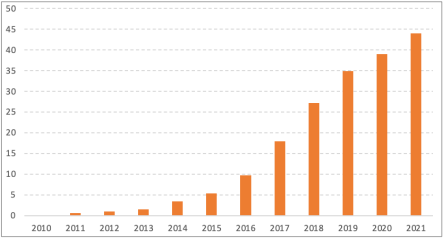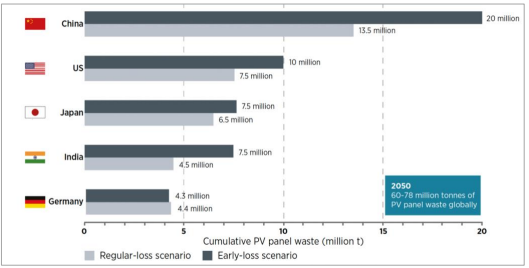Setting the Context: The year 1860 witnessed the invention of the world’s first solar energy system by French inventor Augustin Mouchot. He predicted that our coal supply would eventually run out; and that power would be produced from solar energy. More than 160 years later, the share of renewables (including hydro) in global electricity generation touched 28%.
As Muchot predicted, this clean energy transition has proved to be necessary - not because we’ve run out of coal, but because of climate change. The last few years have witnessed extreme weather impacts—record-breaking heat waves in parts of India, the U.S. and Canada; floods triggered by heavy rainfall in Europe, China, and the U.S; droughts in Africa; and forest fires in Turkey. A recent Intergovernmental Panel on Climate Change (IPCC) report shows that emissions of greenhouse gases from human activities are responsible for approximately 1.1°C of warming and estimates global temperatures will reach or exceed 1.5°C of warming within the next 20 years.
This is a wake-up call for global leaders to take urgent action, be it net zero targets or deep decarbonisation goals. Almost 137 countries have now committed to achieve carbon neutrality by 2050, confirmed by pledges to the Carbon Neutrality Coalition. Carbon neutrality, or net zero, aims to nullify the addition of new emissions to the atmosphere, moving towards a balanced “give-and-take” relationship with the planet. India has made significant progress over the last decade—reduced dependency on fossil fuels, increased RE generation, and improved access to reliable and quality electricity for all.
Further, India has achieved only 122 GW of the target of 175 GW of renewable energy by 2022, and is now expanding it to 450 GW by 2030. The key to achieving these targets lies in efficient and effective resource utilization and a shift away from fossil fuels.
What is a Circular economy?
A circular economy entails markets that give incentives to reusing products, rather than scrapping them and then extracting new resources. In such an economy, all forms of waste, such as clothes, scrap metal and obsolete electronics, are returned to the economy or used more efficiently. This can provide a way to not only protect the environment, but use natural resources more wisely, develop new sectors, create jobs and develop new capabilities.
A circular economy values everything. All resources are utilized to their full potential through the reduction, reuse and recycling of waste. This approach not only reduces carbon emission but also builds climate change resilience.
A circular economy has the potential to accelerate the path to achieve carbon neutrality. It also accelerates deep decarbonisation while reducing the dependency on imports of raw materials, reductions in waste generation, energy use and emissions to the environment.
Circular economies can be planned around any resource, but circular economies planned around the use of fossil fuels are particularly effective in reducing carbon emissions. Circular economies can be thought of as an in-between step in our full transition to clean energy.
Example of circular economy in fuel consumption: A good example of a closed or circular economy is the way Uber operates its Uber Pool Service. Here, the Uber company looks for riders who have matching / similar destinations. This not only saves time but also travel costs for the passenger and fuel costs for the driver.
Impacts of fossil burning: Fossil fuels have been a primary source of energy for centuries. There is no denying that the power sector is the largest generator of carbon emissions. The sector must be decarbonised.

Fig 1: : Carbon Emissions - Sectoral Split 2019 |Source: India Energy Outlook 2021, pg. 55
The transition from fossil fuels to renewable energy (RE) is the only way to ensure sustainable growth. A transition to clean energy solutions is not a choice but a necessity to ensure sustainable socioeconomic development.
Designing for Circularity While Decarbonising: The growth of RE depends on availability of raw materials that can be easily recycled and reused. As per the recent Circularity Gap Report, switching to a circular economy could reduce greenhouse gas emissions by 39% and ease pressure on virgin materials by 28%, saving 23 billion tonnes of carbon emissions. The declining cost of solar energy has paved the way to install more solar capacity and also reduce reliance on fossil fuels. However, as the number of solar installations increases, so do the number of panels that reach their end of life. Figures 2 and 3 capture the increase in global cumulative Photovoltaic (PV) capacity and increase in solar PV capacity in India.

Fig 2: Projected Global Cumulative PV Capacity | IRENA and IEA

Fig 3: Cumulative Solar PV Capacity (GW) in India | IRENA and IEEFA
Figure 4 points out a crucial study by the International Renewable Energy Agency (IRENA), which estimated 78 million tonnes of solar PV waste will be accumulated by 2050. The amount of PV waste in India is estimated to grow to 200,000 tonnes by 2030 and to around 1.8 million tonnes by 2050.These estimates may increase as India moves towards its clean energy target of 450GW of RE by 2030.

Fig 4: Cumulative Solar PV Waste Volume of Top Five Countries in 2050 | IRENA
Thus, critical materials mined from e-waste—including rare earth elements needed to manufacture solar panels, electric vehicles, and batteries—offer a great opportunity for securing their future availability. In India, a lack of domestic reserves makes a circular economy even more important for domestic manufacturing. Shifting to a circular economy model will not only deliver climate benefits but will also provide newer and better growth opportunities.
Status of solar e waste recycling situation in India: Till now, there was no solar e waste policy or recycling in India. But recently,the Minister of Power and New and Renewable Energy said that the management of waste generated from solar photovoltaic modules, panels, and cells has been added to the E-Waste Management Rules, 2022 which was announced in November 2022.
Every manufacturer and producer of solar photovoltaic modules and cells must store the waste generated up to the year 2034-35 according to Central Pollution Control Board (CPCB) guidelines. All solar equipment and material producers must register themselves on the Ministry of Environment, Forest & Climate Change’s (MoEF) E-Waste Management System portal. They must ensure that the processing of waste other than the solar PV modules or panels or cells is done as per the applicable rules. They are required to comply with the standard operating procedure laid down by the CPCB while storing solar waste. The manufacturers must also ensure that the inventory of solar modules or cells is put up on the portal. The recyclers of solar modules and cells will be responsible for the recovery of useful materials from them as per CPCB norms.
Add new comment